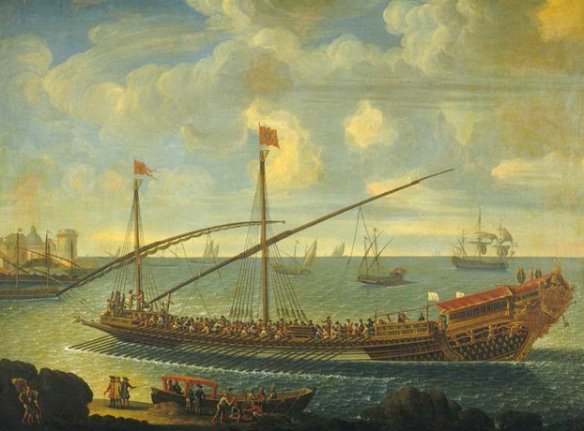
The name “REALE” indicates that the galley belonged to the King of France; also from 1526 the admiralty vessel of the Captain of the French galleys was called “REALE”. The original craft is an exact reproduction of a typical end of 18th century “REALE”, sumptuously decorated by the famous sculptor Pierre Puget; the stern ornamentations, still conserved today, are displayed in the “Musée de la Marine”, Paris.
A large part of the reconstruction is based on old original plans, integrated, where necessary, from other securely reliable sources. The 1:60 scale model is a reproduction of a vessel with a total length of 63m, 9.70 m wide at the over deck carrying 59 thwarts and 50 oars, each maneuvered by 7 men; there were therefore 413 oarsmen alone: small part of them were slaves, but the majority criminals condemned to life imprisonment, while the “heard oarsmen”, i.e. the men at the end of the oar handles, were regularly paid volunteers. The rest of the crew consisted, besides the officers at the stern, in a galley sergeant and two helpers (who, from the midway, whipped the oarsmen to urge them on) and a variable contingent of soldiers and gunners, located on the forecastle and along the arbalesters.
The arms consisted in 5 pieces in bronze, concentrated to bow under the forecastle on special sliding-carriages and by 11 swivel guns dislocated on the arbalesters; to modify the traverse of the forecastle guns, the ship had to move: this clearly denotes the limits of use of the galleys, their sole tactics being the frontal attack of ramming. To be used as a sailing vessel the “REALE” was equipped with two lateen sails; before entering into battles, the sails were always furled and the lateen yard chained to the masts to prevent them striking the oarsmen due to enemy gunfire. As it was very low on the waterline, the covering was often flooded, and sailing under strong wind, the entire part affected, thwarts and rowers included, was immersed.
In the 18th century, the sole possibility for a galley to enter into battle against a heavily armed ship was to take advantage of the smooth sea and choose its combat position, directing the bow on the enemy; due, however to the poor armaments, it took a large number of galleys, to defeat three medium-armed masts.
To bear this out, we recall that in 1651 the frigate LION COURONNE, with only 26 canons, withstood the attack of eleven galleys, while, in 1684, the vessel LE BON alone was victorious against 35 galleys. The battle of Matapan in 1717 was the last one in which galleys took an active part.